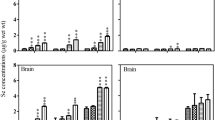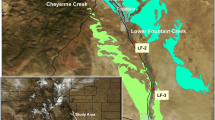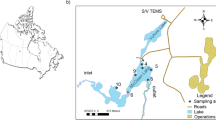Abstract
Sediments are the major sink for selenium (Se) in aquatic environments. Se speciation in sediments is crucial for its bioavailability and toxicity in benthos, but this is relatively understudied. In this study, the background levels of Se in the river sediments, fish flakes, and Lumbriculus variegatus were also detected. Then, the dynamic changes of selenium speciation and concentrations in sediments were investigated after adding selenite (Se(IV)) and seleno-L-methionine (Se-Met) in the sediments for 90 and 7 days, and the accumulation and depuration of Se(IV) and Se-Met for 7 days in the oligochaete L. variegatus were also explored. Without the presence of worms, the levels of Se(IV) in the sediments were relatively stable within 7 days but showed a decreasing trend during the 90 days of aging. In contrast, Se-Met in the sediments showed a sharp decrease within 3 days of aging. The LC50-96 h values of Se(IV) and Se-Met in L. variegatus were 372.6 and 9.4 μg/g, respectively. Interestingly, the dominant Se species in Se(IV)- or Se-Met-treated L. variegatus was Se-Met, whose level was increased with time in 7 days of exposure. Se was barely depurated from L. variegatus during the 8 days of the depuration period. This study has provided indispensable data on the levels of total Se in the abiotic and biotic matrices and the biodynamics of Se in a representative benthos, which could better understand the ecological risk of Se to the freshwater benthic communities.





Similar content being viewed by others
Data Availability
Yes.
References
Ankley GT, Leonard EN, Mattson VR (1994) Prediction of bioaccumulation of metals from contaminated sediments by the oligochaete, Lumbriculus variegatus. Water Res 28:1071–1076
Bowie GL, Sanders JG, Riedel,GF, Gilmour CC, Breitburg DL, Cutter GA, Porcella DB (1996) Assessing selenium cycling and accumulation in aquatic ecosystems. Clean water: factors that influence its availability, quality and its use. Springer. 93–104
British Columbia Ministry of Education (BCMOE) (2018) Applied design, skills and technology.
Burk RF, Hill KE (2015) Regulation of selenium metabolism and transport. Annu Rev Nutr 35:109–134. https://doi.org/10.1146/annurev-nutr-071714-034250
Canton SP, Van Derveer WD (1997) Selenium toxicity to aquatic life: an argument for sediment-based water quality criteria. Environ Toxico Chem 16(6):1255–1259
Chen H, Yan L, Zhao J, Yang B, Huang G, Shi W, Hou L, Zha J, Luo Y, Mu J, Dong W, Ying GG, Xie L (2019) The role of the freshwater oligochaete Limnodrilus hoffmeisteri in the distribution of Se in a water/sediment microcosm. Sci Total Environ 687:1098–1106
Conley JM, Funk DH, Buchwalter DB (2009) Selenium bioaccumulation and maternal transfer in the mayfly Centroptilum triangulifer in a life-cycle, periphyton-biofilm trophic assay. Environ Sci Technol 43(20):7952–7957
Davis E, Maier K, Knight A (1988) The biological consequences of selenium in aquatic ecosystems. Calif Agr 42(1):18–29
Debruyn AM, Chapman PM (2007) Selenium toxicity to invertebrates: will proposed thresholds for toxicity to fish and birds also protect their prey? Environ Sci Techno 41(5):1766–1770
Dinh QT, Cui Z, Huang J, Tran TAT, Wang D, Yang W, Zhou F, Wang M, Yu D, Df L (2018) Selenium distribution in the Chinese environment and its relationship with human health: a review. Environ Int 112(3):294–309
Dubois M, Hare L (2009) Selenium assimilation and loss by an insect predator and its relationship to Se subcellular partitioning in two prey types. Environ Pollut 157(3):772–777
Fujita M, Ike M, Hashimoto R, Nakagawa T, Yamaguchi K, Soda S (2005) Characterizing kinetics of transport and transformation of selenium in water–sediment microcosm free from selenium contamination using a simple mathematical model. Chemosphere 58(6):705–714
Hamilton SJ (2004) Review of selenium toxicity in the aquatic food chain. Sci Total Environ 326(1–3):1–31
Hyne RV, Hogan AC, Pablo F, Roach AC (2002) Toxicity of selenomethionine-and seleno-contaminated sediment to the amphipod Corophium sp. Ecotox Environ Safe 52(1):30–37
Jagtap R, Maher W, Krikowa F, Ellwood MJ, Foster S (2016) Measurement of selenomethionine and selenocysteine in fish tissues using HPLC-ICP-MS. Microchem J 128:248–257
Janz DM, DeForest DK, Brooks ML, Chapman PM, Gilron G, Hoff D, Hopkins WA, McIntyre DO, Mebane CA, Palace VP (2010) Selenium toxicity to aquatic organisms. Ecological assessment of selenium in the aquatic environment, 141–231
Jasonsmith J, Maher W, Roach A, Krikowa F (2008) Selenium bioaccumulation and biomagnification in Lake Wallace, New South Wales, Australia. Mar Freshwater Res 59(12):1048–1060
Lemly AD (1997) Environmental implications of excessive selenium: a review. Biomed Environ Sci 10(4):415–435
Lemly AD (2004) Aquatic selenium pollution is a global environmental safety issue. Ecotox Environ Safe 59(1):44–56
Leppänen M, Jussi K (1998) Relative importance of ingested sediment and pore water as bioaccumulation routes for pyrene to oligochaete (Lumbriculus variegatus, Müller). Environ Sci Techno 32(10):1503–1508
Li WH, Ju YR, Liao CM, Liao V (2014) Assessment of selenium toxicity on the life cycle of Caenorhabditis elegans. Ecotoxicology 23(7):1245–1253
Li X, Liu H, Li D, Lei H, Wei X, Schlenk D, Mu J, Chen H, Yan B, Xie L (2021) Dietary seleno-l-methionine causes alterations in neurotransmitters, ultrastructure of the brain, and behaviors in zebrafish (Danio rerio). Environ Sci Techno 55(17):11894–11905
Liu H, Li X, Lei H, Li D, Chen H, Schlenk D, Yan B, Luo Y, Xie L (2022) Dietary seleno-L-methionine alters the microbial communities and causes damage in the gastrointestinal tract of Japanese medaka Oryzias latipes. Environ Sci Techno 55(24):16515–16525
Maier K, Ogle R, Knight A (1988) The selenium problem in lentic ecosystems. Lake Reserv Manage 4(2):155–163. https://doi.org/10.1080/07438148809354823
Maier KJ, Foe CG, Knight AW (1993) Comparative toxicity of selenate, selenite, seleno-DL-methionine and seleno-DL-cystine to Daphnia magna. Environ Toxicol Chem
Maier KJ, Knight AW (1993) Comparative acute toxicity and bioconcentration of selenium by the midge Chironomus decorus exposed to selenate, selenite, and seleno-DL-methionine. Arch Environ Con Tox 25(3):365–370
Mansour AT, Goda AA, Omar EA, Khalil HS, Esteban MA (2017) Dietary supplementation of organic selenium improves growth, survival, antioxidant and immune status of meagre, Argyrosomus regius, juveniles. Fish Shellfish Immun 68:516–524
Martinez-Bravo Y, Roig-Navarro AF, Lopez FJ, Hernandez F (2001) Multielemental determination of arsenic, selenium and chromium (VI) species in water by HPLC ICP MS. J Chromatogr A 926(2):265–274
May TW, Fairchild JF, Petty JD, Walther MJ, Lucero J, Delvaux M, Manring J, Armbruster M (2008) An evaluation of selenium concentrations in water, sediment, invertebrates, and fish from the Solomon River Basin. Environ Monit Assess 137(1):213–232
Mount DR, Highland TL, Mattson VR, Dawson TD, Lott KG, Ingersoll CG (2006) Use of the oligochaete, Lumbriculus variegatus, as a prey organism for toxicant exposure of fish through the diet. Environ Toxicol Chem.: Int J 25(10):2760–7
OECD (2007) Test no. 225: Sediment-water Lumbriculus toxicity test using spiked sediment. Paris, France. https://www.oecd.org/dataoecd/15/13/39725224. Accessed 15 Oct 2017
Infante HG, O’Connor G, Rayman M, Wahlen R, Entwisle J, Norris P, Hearn R, Catterick T (2004). Selenium speciation analysis of selenium-enriched supplements by HPLC with ultrasonic nebulisation ICP-MS and electrospray MS/MS detection. J Anal Atom Spectrom 19(12), 1529–1538.
Orr PL, Guiguer KR, Russel CK (2006) Food chain transfer of selenium in lentic and lotic habitats of a western Canadian watershed. Ecotox Environ Safe 63(2):175–188
Presser TS, Ohlendorf HM (1987) Biogeochemical cycling of selenium in the San Joaquin Valley, California, USA. Environ Manage 11(6):805–821
Schroeder RA, Orem WH, Kharaka YK (2002) Chemical evolution of the Salton Sea, California: Nutrient and selenium dynamics. The Salton Sea. Springer, Dordrecht 161:23-45
Schwartz GE, Rivera N, Lee SW, Harrington JM, Hower JC, Levine KE, Vengosh A, Hsu-Kim H (2016) Leaching potential and redox transformations of arsenic and selenium in sediment microcosms with fly ash. Appl Geochem 67(4):177–185
Séby F, Potin-Gautier M, Giffaut E, Borge G, Donard O (2001) A critical review of thermodynamic data for selenium species at 25℃. Chem Geol 171(3–4):173–194. https://doi.org/10.1016/S0009-2541(00)00246-1
Sun YW, Zhang KB, Zhang RQ, Li HX, Lv CW, He J (2021) Pollution characteristics and potential ecological risk of selenium in sediments and fish from Daihai. Environ Chem 40(7):2158–2167 (In Chinese)
Suzuki KT (2005) Metabolomics of selenium: Se metabolites based on speciation studies. J Health Sci 51(2):107–114. https://doi.org/10.1248/jhs.51.107
Tinggi U (2003) Essentiality and toxicity of selenium and its status in Australia: a review. Toxicol Lett 137(1–2):103–110
Wang D, Alfthan G, Aro A, Lahermo P, Väänänen P (1994) The impact of selenium fertilisation on the distribution of selenium in rivers in Finland. Agr Ecosyst Environ 50(2):133–149
Wang H, Chen H, Chernick M, Li D, Ying GG, Yang J, Zheng N, Xie L, Hinton DE, Dong W (2020) Selenomethionine exposure affects chondrogenic differentiation and bone formation in Japanese medaka (Oryzias latipes). J Hazard Mater 387:121720
Wang MC, Chen HM (2003) Forms and distribution of selenium at different depths and among particle size fractions of three Taiwan soils. Chemosphere 52:585–593
Winger PV, Lasier PJ, White DH, Seginak JT (2000) Effects of contaminants in dredge material from the lower Savannah River. Arch Environ Contam Toxicol 38(1): 128–136
Xie L, Wu X, Chen H, Luo Y, Guo Z, Mu J, Blankson ER, Dong W, Klerks PL (2016) The bioaccumulation and effects of selenium in the oligochaete Lumbriculus variegatus via dissolved and dietary exposure routes. Aquat Toxicol 178:1–7
Xie L, Lambert D, Martin C, Cain DJ, Luoma SN, Buchwalter D (2008) Cadmium biodynamics in the oligochaete Lumbriculus variegatus and its implications for trophic transfer. Aquat Toxicol 86, 265–271
Zhang C (2013) Speciation of chromium and selenium in environmental samples. China University of Geosciences. Thesis. (in Chinese)
Zhang Y, Moore JN (1997) Environmental conditions controlling selenium volatilization from a wetland system. Environ Sci Techno 31(2):511–517
Funding
The authors thank the National Key Research and Development Program of China (2018YFC1801200, 2018YFD0900601), the National Natural Science Foundation of China (31960733, 41877366, 41807352, 42107292, 42177256, 42177257), the Guangdong Basic and Applied Basic Research Foundation (2019A1515110789, 2020A1515010508), and Special Fund for the Construction of Modern Agricultural Industry Technology System (CARS-46) for financial support.
Author information
Authors and Affiliations
Contributions
Jichen Yang: Conceptualization, software, investigation, writing—original draft. Xin Yan: Conceptualization, software, investigation, writing—original draft. Hongsong Liu: Investigation, data curation. Hongxing Chen: Software, funding acquisition. Wei Zhang: Funding acquisition, writing—review and editing. Wu Dong: Funding acquisition, writing—review and editing. Dan Li: Funding acquisition, writing—review & editing, supervision. Lingtian Xie: Conceptualization, funding acquisition, writing—review and editing, supervision.
Corresponding author
Ethics declarations
Ethics approval
No.
Consent to participate
Yes.
Consent for publication
Yes.
Competing interests
The authors declare no competing interests.
Additional information
Responsible Editor: Christian Gagnon
Publisher's note
Springer Nature remains neutral with regard to jurisdictional claims in published maps and institutional affiliations.
Supplementary Information
Below is the link to the electronic supplementary material.
Rights and permissions
About this article
Cite this article
Yang, J., Yan, X., Liu, H. et al. Laboratory study of Se speciation in the sediment and oligochaete Lumbriculus variegatus from an aquatic environment. Environ Sci Pollut Res 29, 90435–90445 (2022). https://doi.org/10.1007/s11356-022-22108-7
Received:
Accepted:
Published:
Issue Date:
DOI: https://doi.org/10.1007/s11356-022-22108-7




